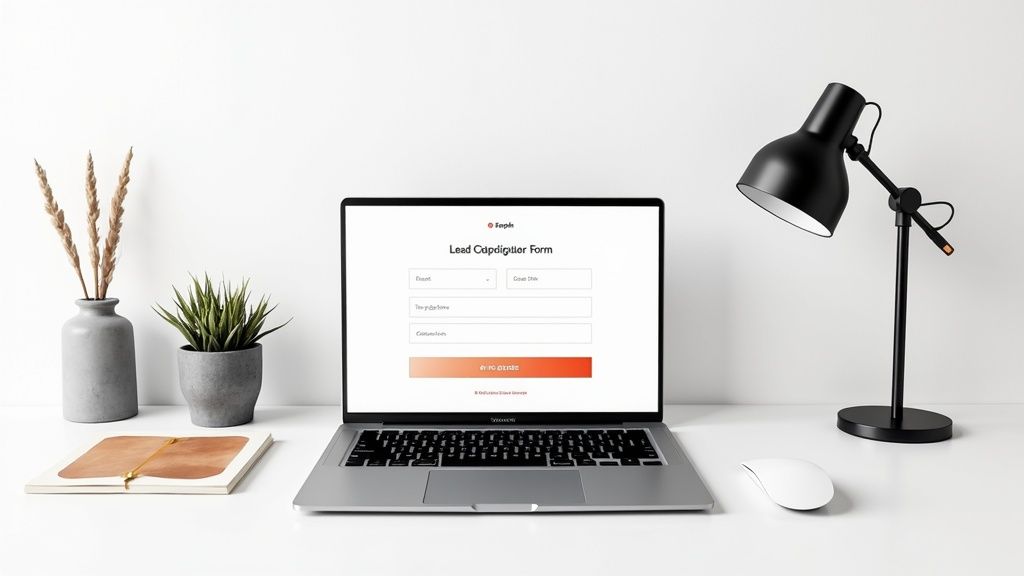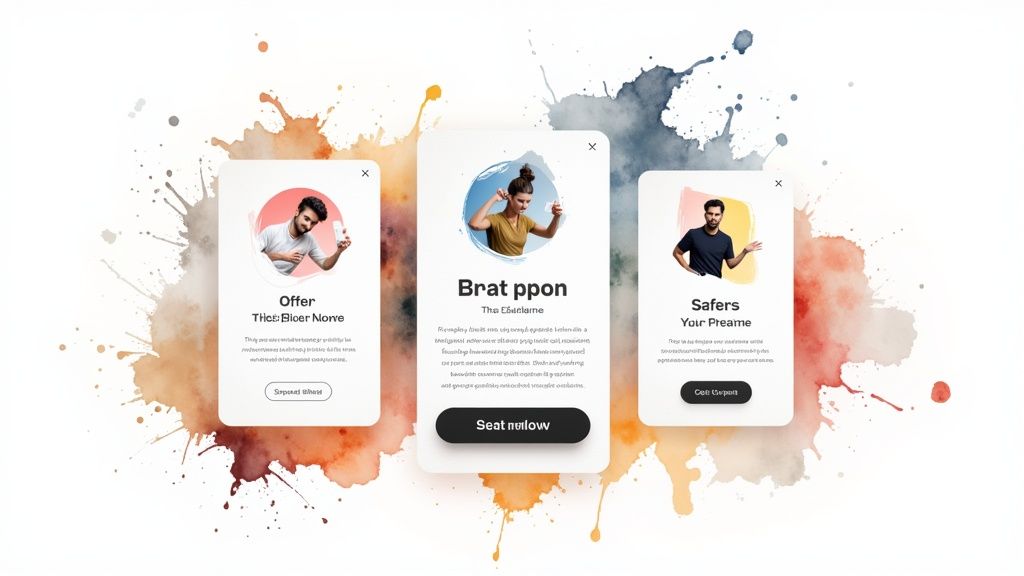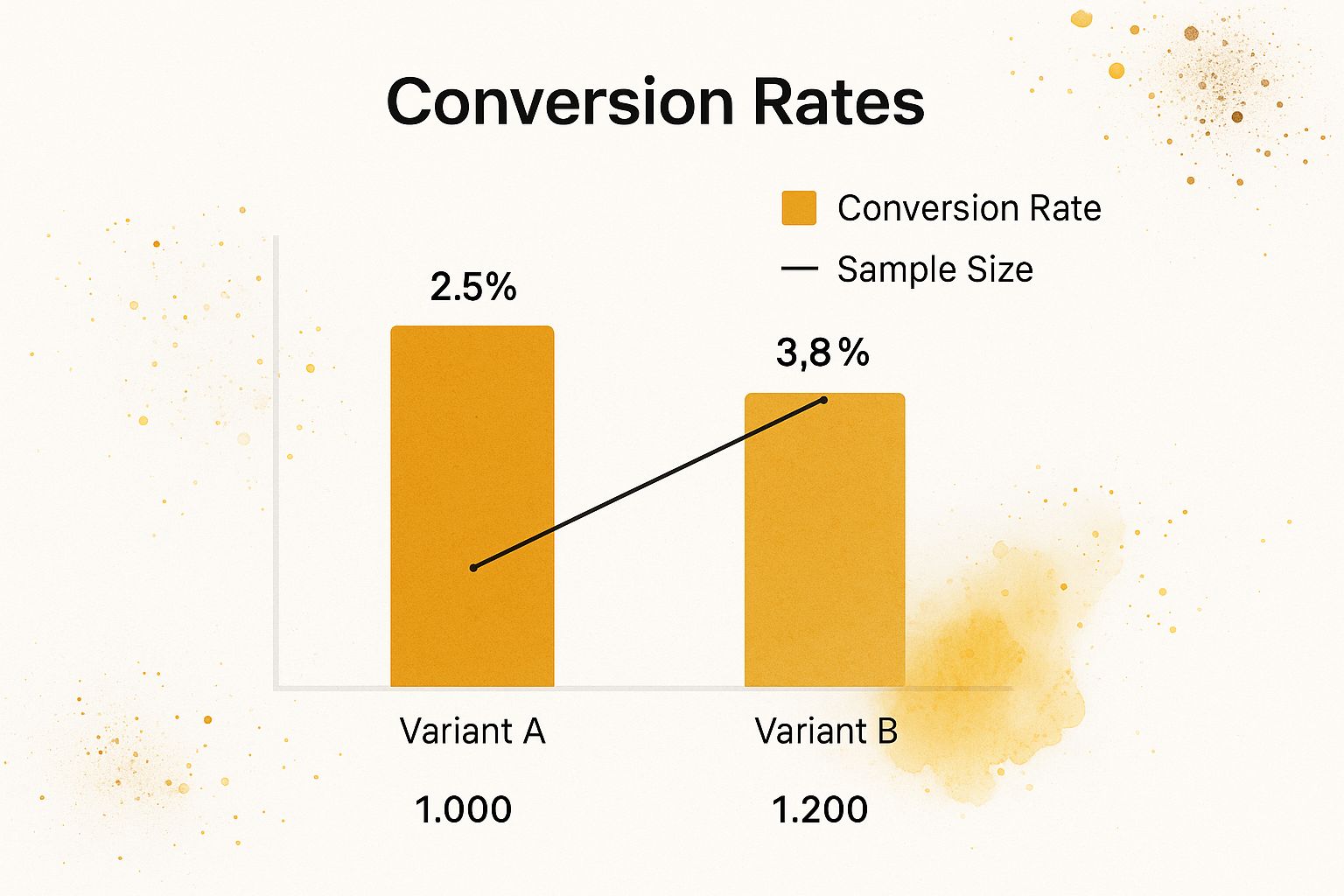Lead Capture Landing Page Tips for Proven Results
Why Single-Purpose Pages Outperform Everything Else
Let's talk lead capture landing pages. A common mistake? Trying to cram way too much onto one page. It's like a circus act – entertaining, maybe, but not effective for getting what you want (leads!). I've worked with a lot of marketers, and the ones who really nail lead generation? They understand the power of focus. Seriously, laser-focused landing pages crush generic ones, sometimes boosting conversions by a mind-blowing 300% or more.
Why? Visitor psychology. People arrive on your page with a specific need. Overwhelm them with multiple offers or confusing navigation, and they'll bounce faster than a rubber ball. Imagine walking into a shoe store for running shoes and finding yourself surrounded by lawn gnomes and power tools. You'd probably head for the exit, right?
I've seen firsthand how clarifying a page's purpose can double leads. I worked with a software company whose landing page promoted three different products. Conversions were terrible. We split it into three separate lead capture landing pages, each tailored to a specific product and audience. Leads went through the roof. Speaking of tracking performance, checking your digital marketing performance metrics is essential. This gives you real data to work with, not just guesses.
Landing Page Length and Design
Here's a curveball: longer landing pages can actually be better. I know, it sounds crazy. But hear me out – long-form landing pages can generate up to 220% more leads than shorter ones. Why? Because in-depth, relevant content builds trust. It addresses questions and objections, especially for complex products where visitors need more information before committing. Want more data on this? Check out these landing page statistics. Combining a clear purpose with thoughtful design and the right length is the secret sauce for a high-converting lead capture landing page.
Let's take a closer look at how landing page purpose impacts conversion rates. The table below shows some typical examples.
Landing Page Purpose vs. Conversion Rate Comparison
Here's a comparison of different landing page purposes and their typical conversion rates. This should give you a better idea of what to expect and how to tailor your page for optimal performance.
| Purpose Type | Average Conversion Rate | Best Use Case | Key Elements |
|---|---|---|---|
| Lead Generation | 2-5% | Gathering contact information for future outreach | Compelling offer, clear call to action, concise form |
| Product Demo | 5-10% | Showcasing a product's features and benefits | Engaging visuals, clear value proposition, demo request form |
| Free Trial Signup | 10-15% | Getting users to try a product or service | Low barrier to entry, clear benefits, easy signup process |
| Purchase | 1-3% | Directly selling a product or service | Strong product imagery, clear pricing, secure checkout |
As you can see, different purposes require different strategies. A free trial signup page will likely convert at a higher rate than a direct purchase page because the commitment level is lower. Understanding these nuances will help you set realistic goals and optimize your pages effectively.
Forms That Feel Like Conversations, Not Interrogations
Let's be honest, nobody enjoys filling out online forms. They're tedious, often intrusive, and can feel like pulling teeth. Yet, some lead capture landing pages manage to convert at an impressive 40%, while others barely scrape 2%. What's the difference? In my experience building countless landing pages, I've discovered the key is to make your forms feel like a friendly chat, not an interrogation.
Too many form fields just scream "intrusion," and that's a guaranteed conversion killer. Think about it – when you meet someone new, you don't bombard them with a list of personal questions, right? You build rapport first. Your landing page should do the same. Earn your visitor's trust before asking for their information.
Form Fields: Less is More
One of the most common mistakes I see is asking for too much upfront. Every extra field increases the chance of someone abandoning the form. Ask yourself: "Do I absolutely need this information right now to qualify this lead?" If the answer is no, ditch it. You can always collect more data later through email nurturing or follow-up interactions.
For instance, if you're offering a free ebook on lead generation strategies, do you really need someone's company size and job title at this point? Probably not. Their name and email are enough to deliver the ebook and start a conversation. Tools like Linkero offer flexible form builders, so you can tailor your forms to each specific landing page and offer.
 This Unbounce screenshot shows a clean, minimalist landing page with a concise form. It highlights a single compelling offer, minimizing distractions and boosting conversions. The takeaway? Keep it clear, keep it brief.
This Unbounce screenshot shows a clean, minimalist landing page with a concise form. It highlights a single compelling offer, minimizing distractions and boosting conversions. The takeaway? Keep it clear, keep it brief.
The Phone Number Dilemma
Phone numbers are a tricky one. They're valuable for sales, but asking for them too early can be a major turn-off. My rule of thumb: only ask for a phone number if it's essential for the very next step, like scheduling a demo or consultation. Otherwise, prioritize building trust and nurturing the lead via email. You might be surprised how many people are happy to share their phone number after experiencing the value you offer.
Headlines That Stop the Scroll and Start Conversations
Your headline has about three seconds to make an impression. Seriously. It's like a first date – you want to grab their attention without being cheesy. How do you do that on your lead capture landing page? Let's talk strategy. I've spent a lot of time digging into high-performing landing pages, and I've noticed some key trends.
The Psychology of a Powerful Headline
The best headlines speak to your ideal customer’s needs, either by bringing up their pain points, piquing their interest, or offering a solution they’re looking for. For example, "Free Ebook" is generic and doesn't tell anyone anything. But something like "Stop Wasting Time on Social Media: The Ultimate Guide to Content Scheduling" is way more effective. It addresses a specific pain point (wasted time) and offers a real solution (content scheduling).
Urgency can also work wonders. Think “Limited-Time Offer” or “Download Now Before It's Gone.” But, a word of caution: Don't overdo it. Fake scarcity just feels slimy. Keep it real.
Headline Formulas That Work
While each headline should be unique, certain formulas tend to perform well. Here are a few I've seen work well on Linkero landing pages:
- The Problem/Solution Headline: "Struggling with Lead Generation? This Simple Trick Will Double Your Conversions."
- The Question Headline: "Are You Making These 5 Common Landing Page Mistakes?"
- The How-To Headline: "How to Create a Lead Capture Landing Page That Converts Like Crazy."
- The Benefit-Driven Headline: "Generate More Leads in 30 Days With Our Proven System."
Play around with these and see what works for your audience. Testing is key! Linkero makes it super easy to create different versions and track performance.
Speaking to Your Ideal Customer
The most effective headlines address what your visitor is already thinking. What are their doubts? What are they hoping for? Try to anticipate these questions and answer them right in your headline. For instance, if you know people are hesitant to give their email, try something like "Get Instant Access to Our Free Guide (We Hate Spam Too!)." This conversational tone makes your page feel more personal and trustworthy, boosting your chances of getting that conversion. Remember, your headline is the start of a conversation, not just a few words on a page.

Why One Landing Page Never Fits All

Let's be honest, treating all your website visitors the same is like using the same fishing lure for every type of fish. Your Facebook traffic nibbles at different bait than your Google Ads crowd. Someone hooked from an email expects a different reward than someone snagged on Instagram. Use a generic lead capture landing page for everyone, and you're going to miss a lot of keepers. Trust me, I've seen it happen more times than I care to remember.
Savvy marketers know this. They build targeted landing pages—custom-crafted experiences for each slice of their audience. Think of it like this: you're running a promotion on Instagram for a photography course. Your landing page should feel like a natural extension of your Instagram feed, using similar visuals and language. This smooth transition reinforces the message that initially grabbed their attention.
Tailoring Your Value Proposition
This targeted thinking also applies to your value proposition. A juicy worm for one fish might not appeal to another. A free trial might hook your Facebook audience, but a discount code could reel in email subscribers. The key is understanding what motivates each group. Need some inspiration for naming your lead capture landing page? The LinkedIn Page Name Generator can be a great tool for sparking some creative titles.
Also, consider where each audience is in their buying journey. Someone searching Google for "best project management software" is likely ready to buy compared to someone clicking a link in your Instagram bio. Your landing page needs to reflect that. The searcher probably wants comparison charts and detailed features, while the Instagram visitor might just need a quick overview and a tempting free trial.
Managing Multiple Landing Pages Efficiently
Now, I know what you're thinking: managing multiple landing pages sounds like a headache. But it doesn't have to be. With a platform like Linkero, you can easily clone pages and tweak them for each audience, no need to reinvent the wheel every time. This lets you scale your lead generation efforts without pulling your hair out. You can even use a similar approach for building a one-page website. Plus, increasing your number of landing pages can significantly impact lead generation. Companies see a 55% increase in leads when they go from 10 to 15 landing pages. Pretty impressive, right? Discover more insights. This targeted strategy is far more effective than a one-size-fits-all approach. You’ll connect with each audience on a deeper level, resulting in more qualified leads and, ultimately, more conversions.
Scaling Your Lead Generation With Strategic Page Creation
Ready to kick your lead generation into high gear? The real game-changer isn't just having a landing page, it's having a whole portfolio of them, each strategically designed. I've witnessed firsthand how businesses go from barely any leads to a consistent flow just by implementing this approach. It's all about working smarter, not harder.
Identifying Your Top Landing Page Opportunities
First things first, you need to figure out which new landing pages to build. Don't just create them randomly! Look at your data. What's getting the most attention? Which parts of your audience are most likely to convert? For example, if you see a ton of clicks on your social media ads for a particular product, that's a golden opportunity for a dedicated landing page. Tools like Linkero's analytics can also help pinpoint which traffic sources are bringing in the most qualified leads. Need some inspiration? Check out these examples of successful lead generation campaigns.
Efficiently Producing Multiple Landing Pages
Creating multiple landing pages doesn't mean reinventing the wheel every time. Use templates and reusable components! Platforms like Linkero make this super easy – you can clone existing pages and tweak them for different audiences or offers. This saves you a bunch of time and keeps your branding consistent across all your landing pages. Think of it like building with LEGOs – you have the same basic blocks, but you can arrange them in countless different ways.
Managing Your Landing Page Portfolio
As your landing page collection grows, you'll need a system to manage them. A simple spreadsheet or a project management tool can do the trick. Track each page's purpose, target audience, and key performance metrics. Keep an eye on your analytics and adjust your strategy as needed. Small changes can have a big impact, as you can see in the infographic below.

Variant B, with a slightly larger sample size, had a significantly better conversion rate (3.8%) compared to Variant A (2.5%). This really highlights the importance of constant testing and optimization.
The following table shows a statistical breakdown of how the number of landing pages directly impacts lead generation:
| Number of Landing Pages | Lead Increase Percentage | Typical Business Size | Implementation Timeline |
|---|---|---|---|
| 1-5 | Baseline | Small startups | 1-2 weeks |
| 6-15 | 100-200% | Growing businesses | 1-3 months |
| 16-40 | 200-400% | Medium-sized businesses | 3-6 months |
| 40+ | 500%+ | Large enterprises | 6+ months |
Having more landing pages translates to significantly more leads. Companies with more than 40 landing pages generate over 500% more leads than those with fewer than 10. Want to dive deeper into these stats? Check out these insights about landing page statistics.
Maintaining Brand Consistency While Tailoring to Your Audience
Each landing page should speak directly to a specific audience, but it's crucial to maintain brand consistency. Use similar visuals, messaging, and tone across all your pages. Think of each landing page as a room in your house – they all serve different purposes, but they still fit together within the overall design. This cohesive brand experience builds trust with your audience. Remember, effective scaling is about strategic growth, not just throwing things at the wall and seeing what sticks. Follow these tips, and your landing pages will become a powerful engine for growing your business.
Testing Without the Guesswork
Building a landing page that captures leads is just the first step. The real improvements come from testing and refining. I've personally witnessed marketers skyrocket their conversion rates by 200-500% simply through systematic testing. The best part? You don't need to be a stats whiz to do this.
Prioritize Your Testing Efforts
Don't get overwhelmed trying to test everything at once. Instead, zero in on the elements that pack the biggest punch. Your headline is a great place to start. It's the first thing visitors see, so even tiny changes can have a ripple effect. Next up is your call to action. Is it crystal clear, enticing, and easy to spot? Then, take a look at your form fields. Are you asking for too much information upfront? Could you streamline the process? Finally, consider your overall page layout and design. Does it naturally guide visitors towards your conversion goal?
Creating effective landing pages is a must for marketing agencies. For more on this, check out this helpful resource on building effective landing pages.
Testing With Limited Traffic
You can still achieve meaningful results even without a flood of traffic. A/B testing, where you compare two versions of your page head-to-head, is your best friend here. Tools like Linkero make A/B testing incredibly simple, allowing you to track conversions and see which variation comes out on top. You might be surprised by how small adjustments can lead to substantial gains. For a deeper dive into landing page optimization, our guide on landing page conversion optimization is packed with helpful tips.
Avoid Common Testing Mistakes
One of the biggest pitfalls I see is pulling the plug on tests prematurely. Patience is key. Let your tests run their course to gather enough data for reliable insights. Another common mistake is testing too many things simultaneously. This makes it nearly impossible to isolate the specific change that's affecting your results. Keep your tests focused and tweak one variable at a time. And remember, numbers aren't everything. Try to understand the why behind the results. What psychological factors are at play that make certain elements perform better than others?
The Power of Small Changes
Testing isn't about massive redesigns. More often than not, subtle tweaks yield the most dramatic results. I once helped a client boost their conversions by 20% just by changing the color of their call-to-action button. So, don't underestimate the power of small changes. Experiment, see what happens, and you might just uncover some hidden gems.
Your Lead Generation Action Plan
Alright, let's talk strategy. How do we actually use all this info to build a lead-generating machine? This isn't just some theory I'm throwing at you – it's a practical, down-to-earth plan for creating a landing page that converts. Consider it your personalized blueprint for lead generation success.
Prioritize and Implement
Look, I know it’s tempting to want to do everything at once, but trust me on this: start with one killer lead capture landing page. Don’t spread yourself thin trying to build multiple pages right out of the gate. Pick one core offer and make it shine. Linkero is your friend here – use it to quickly build and customize that page. Concentrate on those key elements we’ve talked about: a headline that grabs attention, a form that’s easy to fill out, and a call to action that’s impossible to ignore. A focused page is way more effective than a cluttered one, remember that.
Think about your audience. Who are these people? What keeps them up at night? What are they searching for? Answer these questions on your landing page clearly and concisely. Really put yourself in their shoes.
Track and Measure
Once your landing page is live, you absolutely have to track your key metrics. Forget about vanity metrics like page views – they don’t tell the whole story. What you really need to focus on is your conversion rate. Out of all the people visiting your page, how many are actually filling out your form? This is where Linkero's built-in analytics come in handy – it makes tracking these numbers super simple. Use that data to figure out what's working and where you need to make adjustments.
Let's say your conversion rate is lower than you'd like. No problem! Experiment with different headlines, tweak your call to action, or even play around with the fields on your form. Sometimes the smallest changes can make a huge difference.
Scale Strategically
Once your first landing page is humming along nicely and bringing in leads, then you can start thinking about expanding to multiple pages. Consider different segments of your audience or different products or services you offer. Each page should have a specific purpose and target a specific group. The beauty of Linkero is that you can easily duplicate your existing high-performing pages and tweak them for different audiences. It streamlines the whole process beautifully.
But a word of caution: don’t get carried away and scale too quickly. Quality over quantity, always. A small number of really well-designed, targeted lead capture landing pages will always outperform a dozen generic ones.
Ready to build your first high-converting lead capture landing page? Start building with Linkero today!


